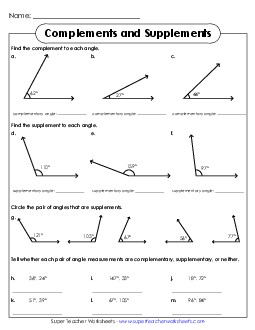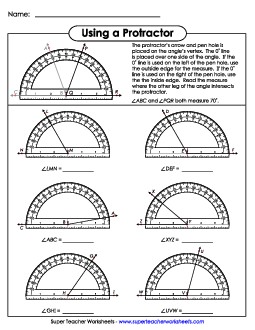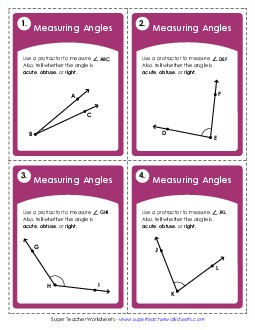Geometry: Angles

Help students learn to differentiate between acute, obtuse, and right angles with these printables. This page features many worksheets and a set of task cards.
Complementary, Supplementary, & Vertical AnglesHelp your students learn to about complementary, supplementary, and vertical angles with these printable teaching resources.
Measuring & Drawing AnglesThis page has worksheets for teaching students to measure and draw angles with a protractor.
Geometry WorksheetsThis page will link you to our full list of geometry topics, including polygons, solid shapes, symmetry, congruence, translation/rotation/reflection, flips/slides/turns, area, perimeter, and more.



Learning about angles is an essential component of elementary school math, typically introduced in third or fourth grade as students begin to explore basic geometry. Understanding angles helps students identify and measure the space between two intersecting lines, which is fundamental to a wide range of mathematical concepts, including shapes, symmetry, and even algebra later on. By recognizing and working with different types of angles—right angles, acute angles, obtuse angles, and straight angles—students develop spatial awareness and a deeper understanding of how the physical world is structured.
In the classroom, teachers use several effective methods to help students grasp the concept of angles. Protractors are commonly introduced as a tool for measuring angles, allowing students to see how different degrees correspond to specific angles. Teachers also employ visual aids like angle charts and diagrams to show the relationship between angles and shapes. Hands-on activities, such as constructing angles with rulers, drawing them on graph paper, or identifying angles in the classroom environment, help make the concept more tangible. Additionally, interactive games and apps that allow students to practice angle identification and measurement make the learning process engaging and fun.
Understanding angles is crucial for students as it lays the foundation for more advanced geometric concepts in later grades. Mastery of angles helps students improve their problem-solving and critical-thinking skills, which are applicable to everything from engineering and design to everyday tasks like reading maps and building objects. Moreover, an early grasp of angles fosters a better understanding of concepts like symmetry, perimeter, and area, which are vital for success in both math and science. By developing a strong understanding of angles, students gain confidence in their mathematical abilities and set the stage for future success in STEM subjects. From learning the types of angles to measuring angles with a protractor, Super Teacher Worksheets has material to help learn!






